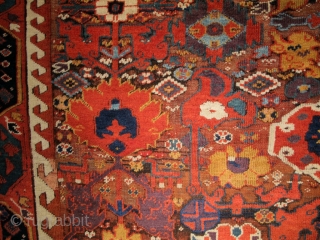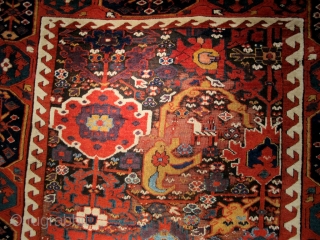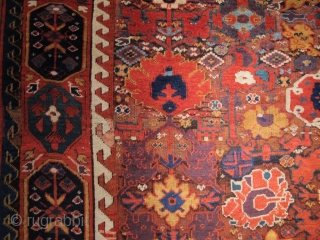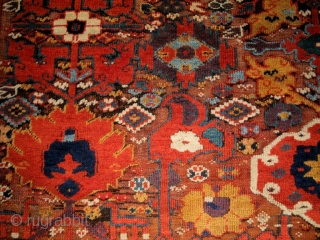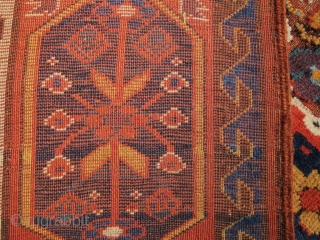Back
Kurdish weavings from Northwest Persia during the 18th and early 19th century are some of the most vibrant and dynamic from any region or group during the post-classical period. This magnificent Kurdish rug from the far north enclave of Sauj Bulagh represents a melding of forms formulated earlier during the Safavid period (1501-1736) with a strong emerging local Kurdish village tradition. The alternating octagons and cartouches of the border are reminiscent of Northwest Persian examples from as far back as the late 15th century, though here they have been fully adapted to accommodate a new Kurdish village sensibility. The field draws a mixture of curvilinear, almost naturalistic, vegetal elements from the repertoire of 18th century 'harassing' design with more geometric elements and even such folk devices as horses and a rider. Color is superlative and radiant approaching magical using a full spectrum of vegetal dyes. Likewise, the wool used is soft, lustrous, and a tactile delight. While much of the brown ground has corroded, a natural phenomenon due to the use of an iron mordant traditionally used for fixing brown dye, a pleasant and very desirable sculptural effect has been created.
size= 5'0" x 8'0" , Inv# 17860
price:
SOLD
- Home
- Antique Rugs by Region
- Category
- Profiles
- Post Items Free
- Albums
- Benaki Museum of Islamic Art
- Budapest: Ottoman Carpets
- Gulbenkian Museum
- Islamic Carpets. Brooklyn
- Islamic Textiles. Brooklyn
- Konya Museum: Rugs
- MKG, Hamburg
- MMA: Caucasian Carpets
- MMA: Mamluk Carpets
- MMA: Mughal Indian Carpets
- MMA: Ottoman Carpets
- MMA: Safavid Persian Carpets
- MMA: Turkmen Rugs
- McCoy Jones Kilims
- Ottoman textiles. Met
- Philadelphia Museum
- Rugs and Carpets: Berlin
- Seljuqs at the Met
- TIEM, Istanbul: Carpets
- V&A: Classical Carpets
- Vakiflar Carpets: Istanbul
- Baluch Rugs: Indianapolis
- Gallery Exhibitions
- Jaf an Exhibition
- Alberto Levi Gallery
- Andean Textile
- Christie's London: 2016
- Francesca Galloway
- HALI at 40
- ICOC Washington, DC 2018
- Jajims of the Shahsavan
- London Islamic Week April, 2018
- Mongolian Felts
- Navajo Rugs: JB Moore
- Persian Piled Weavings
- SF Tribal & Textile Art Show 2020
- SF Tribal 2019
- Sotheby's: C. Alexander
- Turkish Prayer Rugs
- Turkmen Main Carpets ICOC 2007











